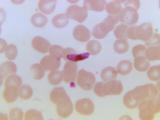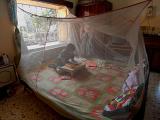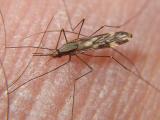Apr 28, 2011
Researchers find method to optimize recovery of anthrax spores
National Institute of Standards and Technology (NIST) researchers have determined the optimal method for recovering spores from a biohazard event and found that simply adding a surfactant to the extraction solution dramatically improved spore recovery, according to an NIST news release. Using the Bacillus anthracis Sterne spores, an attenuated strain used in anthrax vaccines, the NIST researchers studied different combinations of three experimental factors: (1) the type of wipe material (polyester, cotton, or polyester-rayon), (2) the type of extraction solution (deionized water alone, deionized water with Tween 80 surfactant, phosphate-buffered solution [PBS] alone, or PBS with Tween 80), and (3) the method used to agitate the solution to loosen the spores from the wipe after collectioneither vortexing (rapid spinning) or sonication (sound waves applying force). They found that using polyester-rayon wipes in the
field followed by PBS-surfactant extraction and vortexing worked the best. In fact, the combination was 10 times more effective at spore recovery than the least effective combination.
Apr 26 NIST press release
HHS asks NBSB to explore pediatric anthrax vaccine issues
Members of the National Biodefense Science Board (NBSB) today discussed the possibility of forming a working group to explore the safety and efficacy of postexposure anthrax vaccination in children younger than 18. In the event of an anthrax attack, the vaccine from the national stockpile would only be available to adults through an emergency use authorization (EUA) and to children through an investigational new drug protocol. In a letter to the NBSB from Dr. Nicole Lurie, HHS Assistant Secretary for Preparedness and Response (ASPR), said currently there are no safety, immunogenicity, or efficacy data in pediatric populations that would allow the US Food and Drug Administration (FDA) to evaluate the anthrax vaccine for pediatric use under an EUA. She suggested that the NBSB has the expertise to discuss the issue and recommend actions to prepare for possible use in children. George Korch Jr, PhD, acting principal deputy
with the ASPR, said the issues that would need discussion in a working group would be possible design of vaccine research protocols, the risks and benefits, and ethics surrounding its use. Several NBSB members aired challenges that exploring anthrax vaccine for children would raise, such as messaging to parents. Korch said a working group's study of the issue could be a catalyst for examining other uses of countermeasures in pediatric populations.
Apr 28 NBSB agenda
Apr 27 letter to the NBSB from Dr. Nicole Lurie
Surveys examine factors in H1N1 vaccine uptake in public, health workers
In a survey in the Tokyo area during the 2009-10 flu season, Japanese researchers found that people who had an underlying disease or saw themselves as very susceptible to flu were more likely to get vaccinated against the 2009 H1N1 virus, according to a report in PLoS One. From October 2009 to April 2010, the researchers conducted a questionnaire survey of 428 randomly selected adults. At baseline, 57% of the respondents expressed a willingness to be vaccinated, but only 12.1% were vaccinated by the time of a follow-up survey. Those who received the vaccine were significantly more likely to have a preexisting disease, to see themselves as highly susceptible to flu, to be willing to pay for the vaccine even if expensive ($44 or more), to have received a flu shot the previous season, and to have expressed willingness at baseline.
Apr 27 PLoS
One report
Another survey revealed that about 50% of the staff members at a large pediatric hospital in Glasgow, Scotland, received the 2009 H1N1 vaccine, with significantly higher uptake among doctors than other staff members, according to a report published yesterday by Vaccine. The most common reasons for getting vaccinated were a high risk of exposure to H1N1 patients and a responsibility to protect patients. The most popular reasons for avoiding the vaccine included concern about vaccine side effects and safety and being too busy, but 36% of the unvaccinated staff members said they would accept the vaccine if it were offered to them.
Apr 27 Vaccine abstract
Seattle firm lands $8.9 million grant to advance malaria vaccines
Research firm Seattle BioMed received an $8.9 million grant from the Bill & Melinda Gates Foundation to identify biomarkers of protective immunity for malaria vaccines. This research is the firm's first to include its recently announced "systems biology" approach, according to a company press release. "In order to bring the burden of malaria under control . . . we know we need a highly efficacious anti-infection vaccine," said lead investigator Ruobing Wang, MD, PhD. "But, without reliable biomarkers of anti-infection immunity, the development and testing of malaria vaccines is a slow and expensive process." The biomarkers will be used to monitor vaccine efficacy in clinical trials and to select optimal vaccine candidates. Seattle BioMed scientists have developed genetically attenuated whole-parasite vaccine strains that have proven effective in rodents and are now moving toward studies in humans.
Apr
27 Seattle BioMed news release
Research team awarded NIH grant to further chikungunya vaccine research
Researchers from the University of Houston, the University of Texas, and Tulane University have received a 2-year $361,000 federal grant for vaccine development against chikungunya, a potentially debilitating mosquito-borne disease that affects more than 2 million people worldwide each year. The grant, administered by the Western Regional Center of Excellence for Biodefense and Emerging Infectious Diseases Research and funded by the National Institutes of Health, will support development of a novel method of testing potential chikungunya vaccines. The team's method involves studying CD8 T-cells to help determine vaccine response and effectiveness. These tiny cells are notoriously difficult to isolate and study, so the researchers are developing a specialized polymer slide called a microwell array to analyze the T-cells. "Finding a chikungunya vaccine is a priority given the virus' potential to spread quickly and
its possible use in bioterrorism," said University of Houston engineer Navin Varadarajan in a news release yesterday. "With this research, we can help the vaccine developers identify which potential vaccines are most effective and, hopefully, find a suitable one as quickly as possible."
Apr 27 University of Houston press release
Leprosy cases in southern US linked to armadillos
A number of leprosy patients in the southern United States are infected with the same strain of Mycobacterium leprae as is found in wild armadillos in the region, indicating zoonotic transmission, researchers reported today in the New England Journal of Medicine (NEJM). The report says there are cases of leprosy in Louisiana and Texas in people with no history of foreign exposure to the disease, and many armadillos in the region are infected with M leprae. A team of researchers from Louisiana and Switzerland conducted genetic analyses of M leprae from 33 wild armadillos from five southern states, 50 patients from Louisiana, and 64 Venezuelan patients. They identified a unique M leprae genotype, 31-2-v1, in 28 of the armadillos and in 25 of 39 US patients who lived in areas where exposure to armadillos was possible. They concluded that wild armadillos are a large natural reservoir for the pathogen. The
authors state that "Frequent direct contact with armadillos and cooking and consumption of armadillo meat should be discouraged" and add that study suggests that armadillo range expansion should be monitored. In a press release, they also noted that 90% of humans who are exposed to leprosy fight it off without treatment and that the disease is curable with antibiotics.
Apr 28 NEJM abstract
Apr 27 press release



















